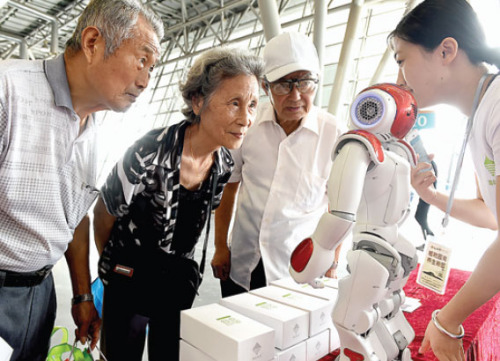
Visitors examine a robot designed to serve the elderly at an expo in Anhui province, on Aug 14. (Photo/Xinhua)
Statistics released by the International Federation of Robotics shows that the major applications for industrial robots include handling, welding, assembly, dispensing, processing and "clean room" work in dust-free environments.
Although most of the robots are used on automobile production lines (38 percent) and the manufacturing of electronic products (27.6 percent), they are also gradually being adopted by traditionally labor-intensive industries, such as foodstuffs and plastic wares, sectors that have suffered most from the labor shortage in recent years.
"From Germany to South Korea to China, a direct factor in employment has been the economic cycle of a country, not the rising number of robots being installed," Qu said.
Wang Yuechao, director of the Bureau of Major R&D Programs at the Chinese Academy of Sciences, said that based on current technology, robots are unable to perform complex tasks that are currently undertaken by senior skilled workers.
"A six-joint robot is already the most sophisticated thing that engineers can build using the current available technology, but its flexibility doesn't compare with our hands at all," Wang said. "So the range of jobs in which robots will replace humans is too narrow to threaten overall employment levels."
Moreover, a report by the International Federation of Robotics said a prosperous robotics industry could created 1 million to 2 million jobs between 2017 and 2020.
"Our study proves that robots create jobs," said Gudrun Litzenberger, general secretary of the federation, in a written statement.
Take Germany, for example, where the number of robots per 10,000 workers rose from 146 in 2000 to 261 in 2011, accelerating manufacturing volume and lowering the unemployment rate from 6.9 percent to 6 percent.
"It's a fact that productivity and competitiveness are indispensable for a manufacturing enterprise to be successful in the global market. Robotics and automation are the solution," Litzenberger said.
The way ahead?
The pursuit of economic growth and high employment has been a top priority for governments around the world in the wake of the 2008 global economic crisis. As a result, many countries have turned to automation.
In 2011, US President Barack Obama included a National Robotics Initiative as part of the wider Advanced Manufacturing Initiative to boost US efforts in automation and robotics.
In 2012, the European Commission set out a plan for a "revolution" to re-industrialize Europe and boost economic growth, with the goal of increasing the contribution of industry to the EU's total GDP to 20 percent by 2020. Robotics and automation is a significant part of the plan.
In recent years, Japan, South Korea and China have all published plans for the development of robotics.
"Some people ask why developed countries need to develop robots when they barely have any strenuous manual work for the robots to do. The answer is that these countries and regions are trying to solve a different problem to China," said Song Xiaogang, executive director of the China Robot Industry Alliance.
"Smart manufacturing"-the use of advanced technologies, such as robotics and 3-D printers, in tandem with a highly skilled workforce-is the ultimate goal of the re-industrialization trend in these highly developed economies, Song said.
"The intention of smart manufacturing is to use automated technology to greatly shorten the R&D period, and thus increase the competitiveness of the companies," Song said.
Currently, complex testing and quality-control procedures mean that launching a product can be a prolonged process. However, if a computer can precisely simulate the testing and production processes, the development period could be shortened correspondingly.


















































